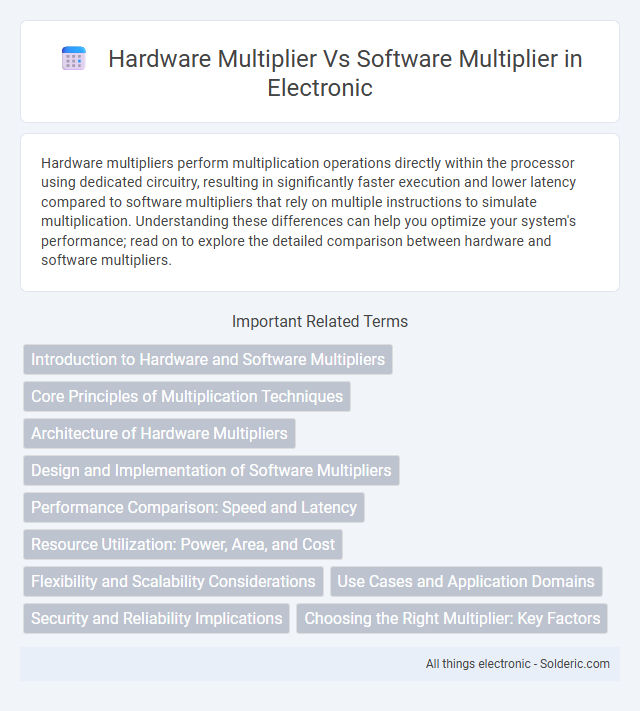Hardware multipliers perform multiplication operations directly within the processor using dedicated circuitry, resulting in significantly faster execution and lower latency compared to software multipliers that rely on multiple instructions to simulate multiplication. Understanding these differences can help you optimize your system's performance; read on to explore the detailed comparison between hardware and software multipliers.
Comparison Table
| Feature | Hardware Multiplier | Software Multiplier |
|---|---|---|
| Implementation | Dedicated digital circuits (e.g., ALU units) | Algorithm executed by CPU instructions |
| Speed | High-speed, near-instant multiplication | Slower, depends on CPU clock and code efficiency |
| Resource Usage | Consumes silicon area and power on chip | Minimal hardware usage, relies on CPU cycles |
| Power Consumption | Higher power, but optimized per operation | Lower power but may increase CPU workload |
| Precision | Fixed precision, often optimized for specific data sizes | Flexible precision depending on algorithm |
| Flexibility | Limited to built-in instruction set | Highly flexible, modifiable algorithms |
| Cost | Increases hardware complexity and cost | No additional hardware cost |
| Use Cases | Real-time systems, DSP, embedded systems | Low-cost devices, legacy systems, simulations |
Introduction to Hardware and Software Multipliers
Hardware multipliers use dedicated circuits like array or Booth multipliers to perform fast, efficient arithmetic operations directly within the processor, significantly improving computational speed and energy efficiency. Software multipliers rely on algorithmic implementations executed by the CPU, which consume more clock cycles and computational resources, limiting their performance in time-critical applications. Embedded systems and high-performance processors commonly integrate hardware multipliers to optimize real-time processing tasks and reduce latency.
Core Principles of Multiplication Techniques
Hardware multipliers use dedicated circuits like array, Booth, or Wallace tree multipliers to perform multiplication at the transistor level, enabling high-speed and parallel processing of binary numbers. Software multipliers implement multiplication algorithms such as shift-and-add or Karatsuba within the CPU using sequential instructions, which can be slower but more flexible across different platforms. Your choice between hardware and software multipliers depends on speed requirements, resource constraints, and application-specific optimizations.
Architecture of Hardware Multipliers
Hardware multipliers utilize parallelism through specialized circuits like array multipliers, Wallace trees, or Booth multipliers to perform multiplication operations at high speed and efficiency. These architectures reduce the number of sequential addition steps by simultaneously handling partial products, significantly improving throughput compared to software multipliers that rely on sequential arithmetic instructions executed by the CPU. The integration of hardware multipliers directly into the processor's data path enables faster and more power-efficient multiplication crucial for applications in digital signal processing and embedded systems.
Design and Implementation of Software Multipliers
Software multipliers rely on algorithms executed by the CPU, making them flexible but generally slower than hardware multipliers, which use dedicated circuits for parallel and high-speed multiplication. The design and implementation of software multipliers involve optimizing algorithms such as the shift-and-add method or Karatsuba multiplication to improve efficiency in resource-constrained environments. Your choice between hardware and software multiplication depends on processing speed requirements and system constraints like power consumption and available silicon area.
Performance Comparison: Speed and Latency
Hardware multipliers significantly outperform software multipliers in terms of speed and latency due to dedicated circuitry that executes multiplication operations in parallel, often completing in a single clock cycle. Software multipliers rely on sequential addition and bit-shifting instructions, resulting in increased execution time and higher latency. Your applications demanding fast arithmetic computations benefit from hardware multipliers by drastically reducing processing delays compared to software-based solutions.
Resource Utilization: Power, Area, and Cost
Hardware multipliers significantly reduce power consumption and processing time by executing multiplication operations directly within the circuit, optimizing Your device's efficiency. They require dedicated silicon area, increasing chip size and manufacturing cost, but this trade-off results in faster computation and lower energy use compared to software multipliers that rely on iterative processing using CPU resources. Software multipliers consume less physical area and cost less upfront but tend to increase overall power usage and computational latency due to extensive use of general-purpose processing units.
Flexibility and Scalability Considerations
Hardware multipliers offer high-speed, fixed-function performance with limited flexibility, making them ideal for applications demanding consistent, low-latency multiplication tasks. Software multipliers, while slower, provide greater flexibility and scalability by allowing algorithmic modifications and adaptation to various data sizes and precision requirements. Your choice depends on whether you prioritize speed and efficiency or adaptability and ease of updates in your system design.
Use Cases and Application Domains
Hardware multipliers excel in real-time signal processing, embedded systems, and high-performance computing where rapid arithmetic operations are critical, such as in digital signal processors (DSPs) and graphics processing units (GPUs). Software multipliers are preferred in general-purpose computing, low-cost microcontrollers, and environments prioritizing flexibility and portability, like mobile applications and basic arithmetic calculations in software development. The choice between hardware and software multiplication hinges on the trade-off between speed, resource utilization, and application-specific performance requirements.
Security and Reliability Implications
Hardware multipliers offer enhanced security by minimizing exposure to side-channel attacks through dedicated circuitry, reducing the risk of information leakage compared to software multipliers that rely on general-purpose processors. Their intrinsic reliability ensures consistent performance and resistance to faults, which is critical for applications requiring dependable cryptographic computations. You benefit from hardware multipliers by achieving stronger protection against tampering and more stable operation in secure computing environments.
Choosing the Right Multiplier: Key Factors
Choosing the right multiplier depends on performance requirements, resource availability, and power constraints. Hardware multipliers offer faster computation speeds and lower latency, ideal for real-time processing and high-performance applications, but consume more silicon area and power. Software multipliers provide flexibility and lower hardware cost, suitable for systems with limited resources or less critical timing, though they result in slower execution times due to processor overhead.
hardware multiplier vs software multiplier Infographic

 solderic.com
solderic.com